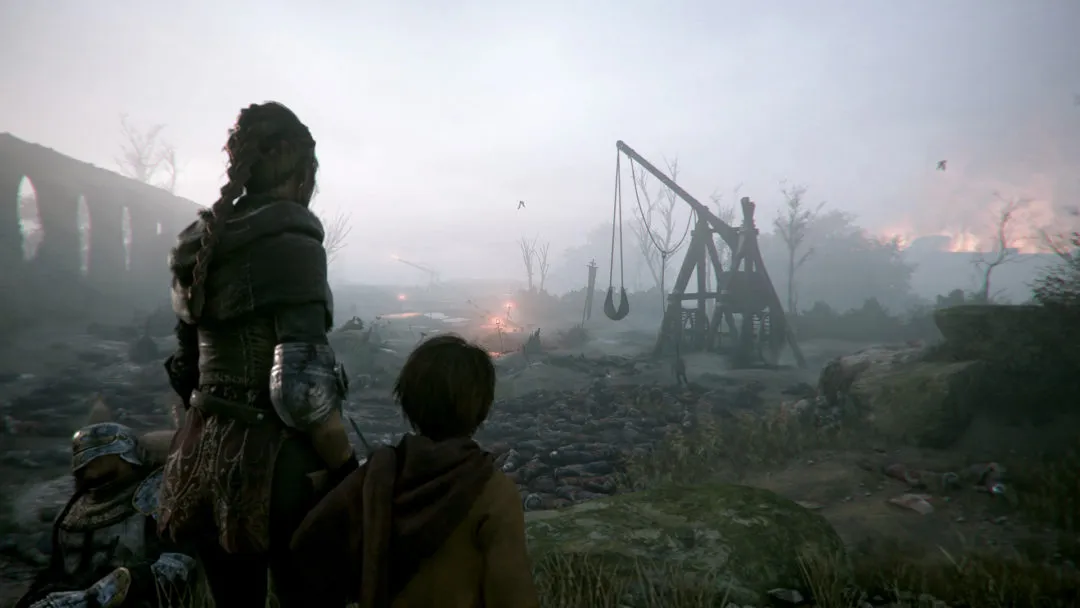This article contains spoilers for A Plague Tale: Innocence.
A Plague Tale: Innocence swept players up in a dark fantasy tale spun from the horrors of the Black Plague. Playing as the teenager Amicia, you clash with the French Inquisition, superstitious locals, and a seemingly unending horde of rats as you protect your young stepbrother, Hugo. Along the way, you meet several colorful companions, some who join you on your journey across France in search of a safe haven. It’s a harrowing journey right up until the end — except for all the times it isn’t.
Despite earning critical acclaim, A Plague Tale: Innocence is a game without proper focus or pacing. The game barely skirts by on emotional beats or momentary novelty that doesn’t really add up. The narrative starts as Half-Life-esque stream of consciousness, only to suddenly start jumping months ahead without warning. The main villain isn’t even introduced until more than halfway through the game. Plot details about your brother, your family, and the Inquisition’s involvement all come to light only minutes before that knowledge becomes critical.
Let’s take an early moment in the game as an example. You’re in a town, fleeing a local knight who’s stirred the townsfolk into a fervor, leading to one of A Plague Tale’s most memorable chase sequences. This would be a perfect setup for the next chapter, which is set in a church’s abandoned catacombs. But you don’t just flee the village; you have to engage in a ham-fisted boss fight with the knight.

The battle introduces a dodge mechanic that will never be needed for future encounters. The confrontation forces Amicia to kill for the first time, but any moral dilemma that would cause is undercut less than two chapters later when she mows down an entire camp of French soldiers without hesitation.
A later scene where you have to sacrifice an adorable pig to distract the rats has much more emotional impact than the fight with the knight. There’s proper justification for why the killing is necessary, and it hammers home the desperate nature of your plight. You’re boxed in and the pig is the only distraction available. Everyone present, especially Amicia and Hugo, feels conflicted about the decision. It’s good drama. The knight was a raving lunatic that terrified everyone. His death is not that of an innocent, but of a broken man. He adds virtually nothing, which is a recurring problem with A Plague Tale.
A Plague Tale sets goals without fully justifying them. Whole sections drag on, which could have a grounding effect if not for the time jumps that become increasingly common towards the game’s conclusion. It’s as if developer Asobo Studio knows certain sequences are unnecessarily tacked on but still opted for 17 chapters where 10 would’ve been acceptable. The team’s time and effort would have been better focused on producing a concrete throughline and steady pace. Instead you never get your bearings.
Months can pass in seconds while almost an hour can be spent just getting to the next major point in the narrative without notable events in-between. The strongest parts of A Plague Tale are lost in a sea of contradictions. The stealth encounters are a highlight, especially when they involve trying to keep Hugo safe and undetected by ensuring he doesn’t have a panic attack. Yet Hugo’s tucked aside so early in the game that you start to forget he was ever present outside of cutscenes.

This also means that when he is reintroduced in later sections, it feels like a mechanical step back from having useful companions who can fend for themselves. Hugo gains utility right at the end, but that requires starting a completely new plot that was only alluded to in passing during preceding chapters. After finally curing your brother, ensuring all your friends are safe, and reaching what seems like a story conclusion, Hugo bolts.
The entire final act of A Plague Tale is kicked off by Hugo losing all sense of reason because of the very slim chance his mother might be alive. Emotion overriding logic is natural in tense situations. Amicia and Hugo’s mother’s fate is implied several times throughout the course of the game, yet it doesn’t invoke the same dramatic reaction before that moment. So why is all this drama delayed until it feels like an epilogue instead of a part of the main story? Because Hugo needs to become a psychic plague rat messiah.
This shift shatters any sense of where the narrative is going next. You’re suddenly playing as Hugo for a whole chapter that introduces this ability and shows how he managed to find his jailed mother. Amicia has a dream sequence that attempts to connect several tertiary characters back into the plot for no clear reason. Then there’s another time jump and Hugo attacks her. Plot twist! He’s evil now! For like 10 minutes. Immediately after that, he’s back on your side and it’s time to fight the man who killed your father in the opening and who’s been bouncing around to remind you that he exists and is awful! He’s essentially this story’s equivalent of Star Wars’ Captain Phasma and goes down about as easily.
You might think that this must be the conclusion. Hugo’s safe, his power’s unlocked, you know your mother’s alive, and the man who killed your father is dead. Obviously the sequel will be about saving the mother and learning about Hugo’s powers, right? Nope. You’ve got two more chapters left where all that gets wrapped up so hastily that it comes across as written in a fever dream. The terrifying story of surviving the Black Plague as a child culminates in two giant piles of different colored rats beating each other up because we’ve apparently changed genres entirely.
None of this adds up. For all its great protagonists and atmosphere, not even the finest actors and level designers could salvage what is essentially a plot fighting with itself. There are multiple story ideas fighting for air in A Plague Tale, and none of them get the space they need. The game would be better if the developers removed whole sections. Just like in Alien: Isolation, there are easily five different points where it seems the story might end only for it to just keep going.
Asobo clearly has the skill to craft something more coherent than this.The first five or so hours of A Plague Tale, mad knight aside, are a focused tale of survival and lost innocence. But the deeper one delves, the more the game becomes unwound. Is it a dark fantasy with magic or arcane science? Is it a horror game? An action game? Does it have Dishonored-style level design, or is it as linear as Uncharted? Is it setting up a franchise, or is it a standalone product? By constantly jumping between themes and ideas, Asobo sacrifices a smooth, well-paced presentation. Quality is more valuable than quantity, and I sincerely hope that if a sequel does come to be that it won’t be as bloated as A Plague Tale: Innocence.







Published: Sep 12, 2019 12:25 pm